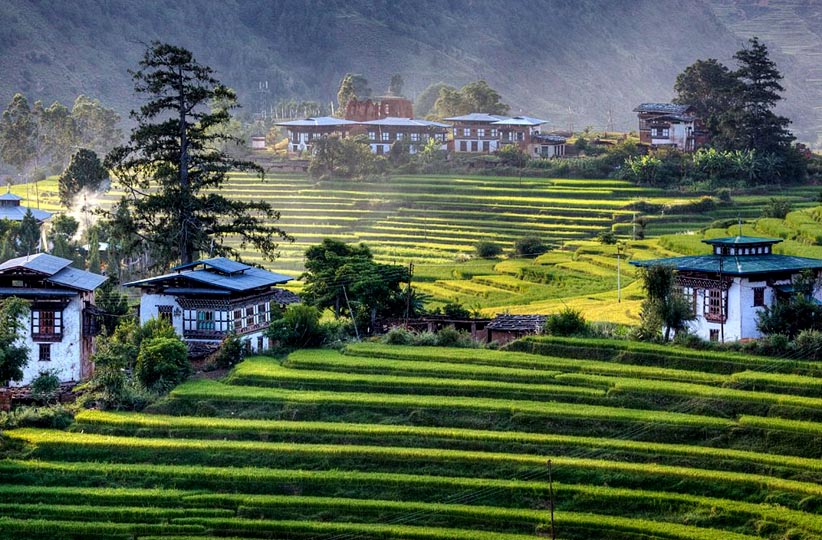
Due to Bhutan’s location and unique geographical and climatic variations, it is one of the world’s last remaining biodiversity hotspots.
Bhutan’s pristine environment, with high rugged mountains and deep valleys, offers ecosystems that are both rich and diverse. Recognizing the importance of the environment, conservation of its rich biodiversity is one of the government’s developments paradigms.
The Constitution of Bhutan states that at any given point of time, 60 percent of the country should be under forest cover. Today, approximately 72% of the total land area of Bhutan is under forest cover and approximately 60% of the land area falls under protected areas comprising of 10 national parks and sanctuaries.
Flora and Fauna
An astonishing array of plants grow in Bhutan: over 5,400 species, including 300 species of medicinal plants, some hardy species thriving even at 3,700m above.
Bhutan has one of the richest stocks of orchids in the world. Of the 369 species, 82 are unique to the mountain kingdom. Bhutan claims 48 of the 1,000 species of rhododendrons found worldwide.
The tropical evergreen forests growing below 800m are repositories of a unique biodiversity. The tropical vegetation of the lower zones gives way to dark forests of oak, birch, maple, magnolia and laurel. Above 2,400m altitude is the home of spruce, yew, and weeping cypress, and higher still, growing up to the tree line, is the east Himalayan fir.
At about 5,500m are low shrubs, rhododendrons, Himalayan grasses and flowering herbs. Bhutan’s national flower, Blue Poppy grows above the tree line 3,500 – 4,500m elevation.
Many rare and endangered species such as the Royal Bengal tiger, Asian elephant, gaur, wild buffalo, wild dog, common leopard, black panther, marveled cat, golden cat, clouded Leopard and Chinese pangolin, Musk derr, Blue Sheep, Takin are seen in Bhutan. Species endemic to the Eastern Himalayan foothills, such as golden langur, capped langur, pygmy hog and hispid hare are found in Bhutan’s oldest park, the Royal Manas Park.
This park alone has a total of 530 species of birds recorded, highest among all protected areas. Apart from the globally endangered species, such as, the Rufous-necked hornbill and Pallas fish eagle, there are 14 other species recorded from the park, which are considered to have globally significant breeding populations in Bhutan.
Physically, the country can be divided into three zones:
1. Alpine Zone (4000m and above) with no forest cover;
2. Temperate Zone (2000 to 4000m) with conifer or broadleaf forests;
3. Subtropical Zone (150m to 2000m) with Tropical or Subtropical vegetation.
Forest types in Bhutan are fir forests, mixed conifer forest, blue pine forest, chirpine forest, broadleaf mixed with conifer, upland hardwood forest, lowland hardwood forest, and tropical lowland forests. Almost 60% of the plant species found in the eastern Himalayan region are present in Bhutan.
As one of the ten global hotspots, Bhutan is committed to preserve and protect its rich environment through its government and environmental organizations. This commitment is apparent in the fact that the kingdom has the distinct honor of being one of the only nations whose forest cover has actually grown over the years.
Some of the proactive organizations working in Bhutan are:
1. Alpine Zone (4000m and above) with no forest cover;
2. Temperate Zone (2000 to 4000m) with conifer or broadleaf forests;
3. Subtropical Zone (150m to 2000m) with Tropical or Subtropical vegetation.
Forest types in Bhutan are fir forests, mixed conifer forest, blue pine forest, chirpine forest, broadleaf mixed with conifer, upland hardwood forest, lowland hardwood forest, and tropical lowland forests. Almost 60% of the plant species found in the eastern Himalayan region are present in Bhutan.
As one of the ten global hotspots, Bhutan is committed to preserve and protect its rich environment through its government and environmental organizations. This commitment is apparent in the fact that the kingdom has the distinct honor of being one of the only nations whose forest cover has actually grown over the years.
Some of the proactive organizations working in Bhutan are:
- National Environmental Commission
- Royal Society for Protection of Nature
- Department of Forest and Park Services.
- Nature Conservation Division
- Bhutan Trust Fund for Environmental Conservation.
- Association of Bhutan Tour Operators.
- WWF
